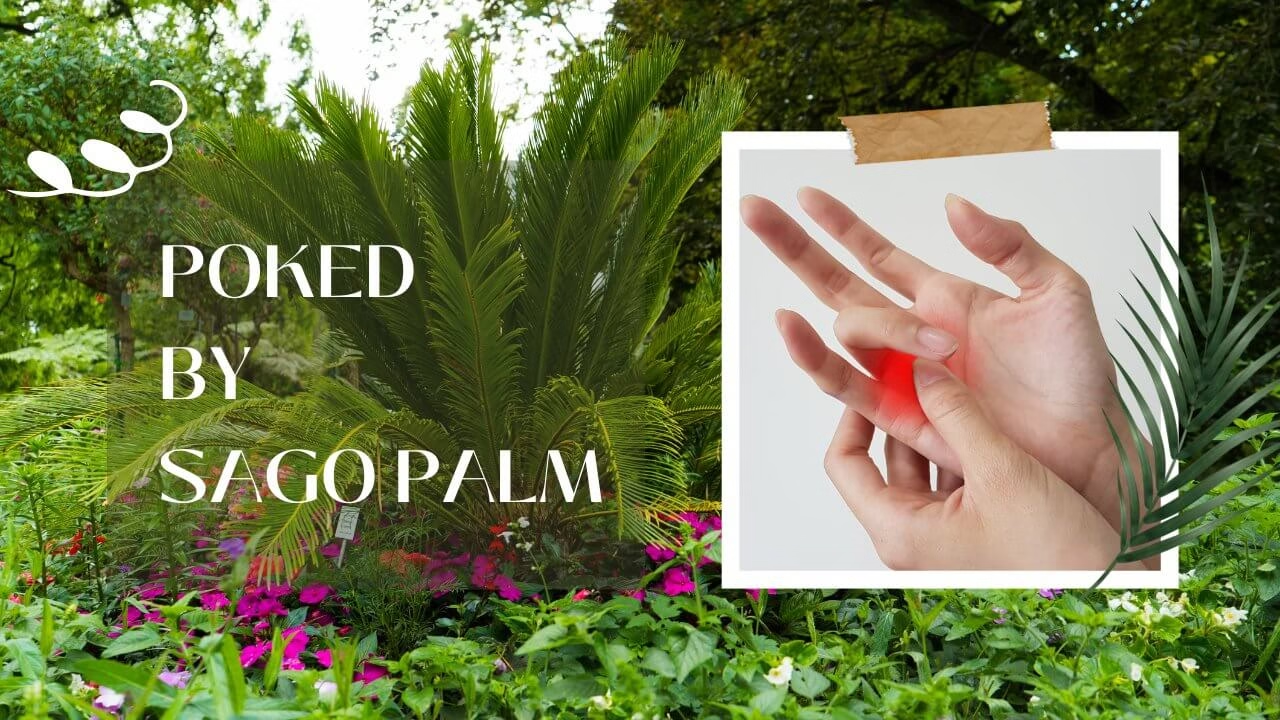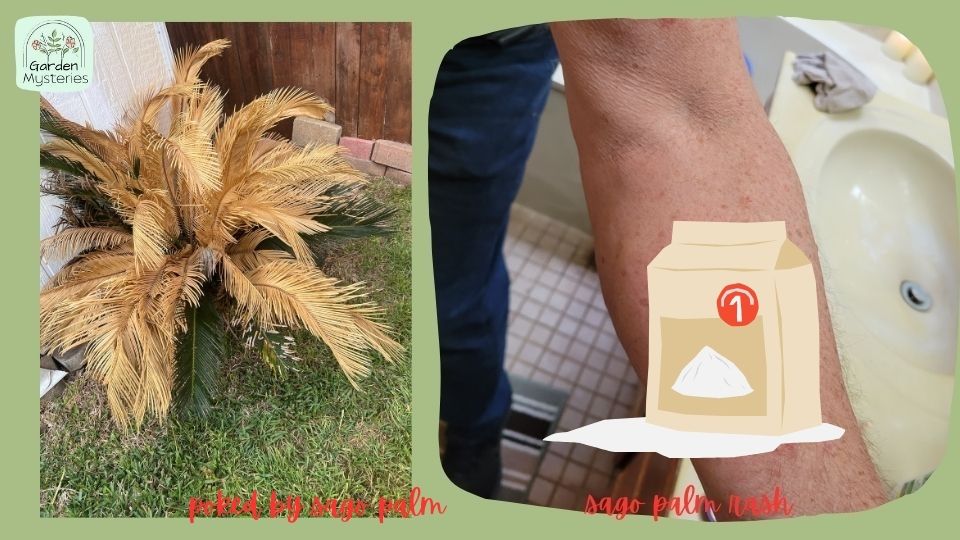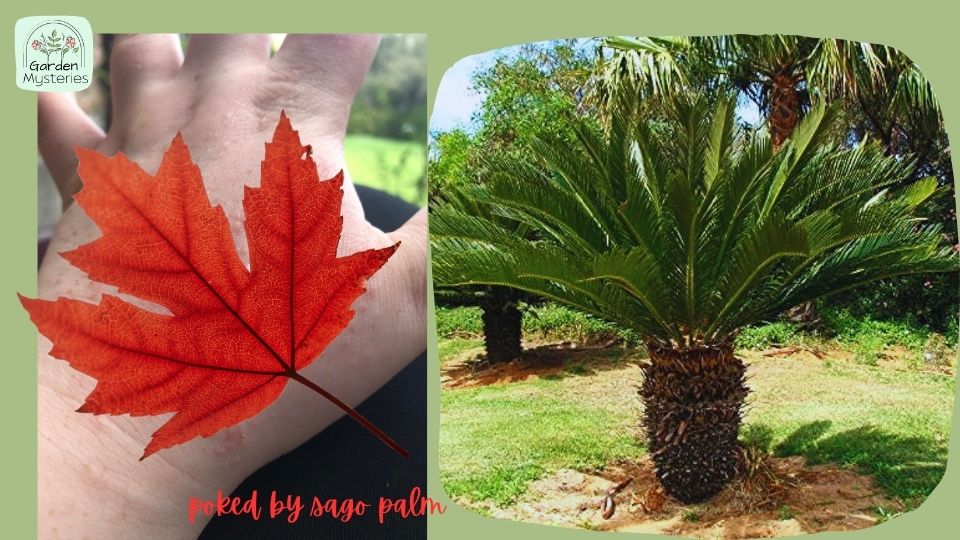
Hey there, fellow gardening enthusiasts. I’m here to share a little mishap I recently had with one of my beloved sago palms. Yep, you guessed it right, I got poked by Sago Palm.
I immediately removed any embedded spines and washed the area with soap and water. Also, I applied antiseptic and covered it with a clean bandage to prevent infection.
Now, I’m not saying this to scare you off, but I want to give you the lowdown on how you can avoid a spiky situation like mine. So, stay sharp till the end.
What To Do If I Get Poked by a Sago Palm?
If you happen to get poked by a Sago Palm, don’t panic. These seemingly innocuous plants can have sharp surprises. First, remove any embedded spine with tweezers, being gentle.
Then, clean the area thoroughly with soap and water to prevent infection. Apply an antiseptic ointment and cover the wound with a clean bandage. You should watch for symptoms like increasing redness, swelling, or signs of infection, although these reactions are rare.
To prevent future pokes, always wear thick gardening gloves when handling your Sago Palm, especially during pruning. You should be careful and deliberate when trimming. Also, you must use sharp, clean tools to minimize frond damage.
Lastly, you must try to maintain a safe distance while working around your Sago Palm, particularly if you’re new to handling them. With these precautions, you can enjoy your Sago Palm without any spiky surprises.
Are Sago Palm Thorns Poisonous’ to Humans?
Sago palm poisonous’ or not! Sago palm thorns, while not poisonous’, can be harmful to humans. The real danger lies in the toxins contained within the plant, primarily in its seeds, not the thorns themselves.
Ingesting any part of the sago palm, especially the seeds, can lead to severe gastrointestinal distress, liver damage, and seizures. In some extreme cases, it can cause coma’ or end. The thorns, however, can cause painful skin-irritation and rashes’ if touched.
Therefore, it’s key to handle sago cycad palms with care. You must wear protective gear like gloves and take precautions to prevent contact with both thorns and any kind of sago palm toxicity from plant parts.
Symptoms and Reactions from Poked by Sago Palm
The sago palm (Cycas revoluta) is a decorative plant that, while visually appealing, should be handled with care. Some parts of the plant, especially the seed,s can trigger unpleasant reactions if ingested or touched. It’s important to be cautious and always consult a medical professional if exposure occurs.
Possible Reactions from Ingesting Sago Palm Parts
Digestive Discomfort: Ingesting parts of the plant may lead to symptoms such as nausea, vomiting, or abdominal upset.
Feeling Unwell or Dizzy: Some individuals may experience confusion, weakness, or general discomfort.
Liver Sensitivity: There have been reports suggesting a potential impact on liver function, including signs like yellowing of the skin.
Serious Reactions: In rare instances, more severe responses like seizures or fainting have been observed. Immediate medical attention is recommended in such cases.
Skin Contact Symptoms
Irritation or Redness: Touching the sago palm’s sharp edges or spines may lead to minor skin reactions like itching or a rash.
Eye Contact Symptoms
Redness or Discomfort: If plant sap gets into the eyes, it may cause irritation or a stinging sensation. Rinse with water and consult a healthcare provider if discomfort continues.
How to Treat After Sago Palm Poisoning
Treating sago palm poisoning requires immediate medical attention because of the potentially severe effects. Here’s what you should do:
Step 1: Call for Emergency Help
Dial your local emergency number or poison’ control center immediately. Provide them with all relevant information, including the type of exposure (ingestion, skin contact, etc.) and any symptoms experienced.
Step 2: Step Do Not Wait for Symptoms
Even if symptoms haven’t appeared yet, seeking medical help promptly is fundamental as sago palm poisoning can have delayed effects.
Step 3: What to Do If Exposure Occurs
If Ingested:
Avoid Inducing Vomiting: In cases of accidental ingestion, it’s generally advised not to induce vomiting unless directed by a medical professional. Doing so may increase discomfort.
Share Helpful Details: If seeking help, try to provide information such as how much was consumed and when the exposure occurred.
Supportive Care in Clinics or Hospitals: Healthcare providers may offer supportive care, such as fluids, symptom management, and careful monitoring. Advanced care may be needed in some cases, depending on individual health responses.
If There’s Skin Contact:
Clean the Area: Gently wash the affected skin with soap and water to remove any plant residue.
Soothe the Skin: Non-prescription skin creams like calamine or hydrocortisone may help calm mild irritation.
When to Call a Professional: If discomfort continues or worsens, it’s a good idea to check with a medical provider.
If There’s Eye Contact:
Flush Gently with Water: Rinse the eye with clean, cool water for about 15 minutes. If you wear contact lenses, remove them after the first few minutes.
Follow Up with an Eye Specialist: Even if things seem fine, having your eyes checked ensures peace of mind and safety.
Remember, there is no specific antidote for sago palm poisoning. Treatment primarily focuses on managing symptoms and providing supportive care.
The prognosis can vary depending on the amount ingested and how quickly medical care is provided. Sago palm toxicity treatment should be decided by a healthcare professional. Always consult a healthcare professional for the best course of action.
You might also have orchids in your garden, right? We often face a common dilemma on whether it’s an Orchid Keiki or Flower Spike. I have your back on this problem. Don’t forget to check out the article.
Can Sago Palms Cause a Rash?
Yes, sago palms can potentially cause a rash, but it’s relatively rare. The primary culprits behind this skin irritation are the needle-like structures known as spines or thorns that line the edges of sago palm fronds.
When the skin comes into contact with these spines, it can lead to skin irritation, redness, and, in some cases, a rash. Individual reactions to sago palm spines can vary widely. Some people may be more sensitive and prone to skin irritation, while others may not experience any adverse effects at all.
It’s essential to note that the sago palm rash is usually not severe and can be treated with standard first-aid measures. If you suspect you’ve been exposed to sago palm spines and develop a rash or skin irritation, wash the affected area with soap and water. Also, you should apply an antiseptic, and monitor it for any signs of infection.
To minimize the risk of a sago palm rash, always wear protective gloves when handling them.
How To Protect Yourself While Handling The Sago Palm
Handling sago palms requires precautions to protect yourself from potential harm. Here’s how to do it:
Wear Protective Gear
- Gloves: Always wear thick, sturdy gardening gloves when handling sago palms. These gloves provide a barrier between your hands and the sharp spines or thorns on the plant.
- Eye Protection: You should consider wearing safety goggles or protective glasses to shield your eyes from sago palm sap or debris while trimming or pruning.
- Long Sleeves and Pants: You can cover your arms and legs with long sleeves and pants to minimize skin exposure.
Use the Right Tools
- Sharp, Clean Tools: You can use sharp and well-maintained pruning shears or loppers to cut sago palm fronds cleanly. Dull tools can cause ragged cuts, leading to sharp edges.
- Avoid Tearing: When trimming, you should cut fronds cleanly rather than tearing them, as torn fronds can have sharp, exposed edges.
Work Carefully and Mindfully
- Slow and Steady: You should take your time when working around sago palms. Rushing can lead to accidental contact with spines.
- Be Aware of Spines: You must pay close attention to the location of spines on the fronds. Handle the plant with care and avoid touching the spines.
- Maintain Distance: You can keep a safe distance from the plant to reduce the risk of accidental contact.
Dispose of Trimmings Safely
- Use Containers: You must place trimmed fronds and plant debris directly into containers or bags, ensuring that the sharp ends are not exposed.
- Secure Disposal: You can seal the containers tightly before disposing of them to prevent injuries to waste handlers.
Wash Hands and Tools
- After Handling: After working with sago palms, wash your hands and any tools used with soap and water to remove any plant residue or sap.
Know the Plant
- Identify Sago Palms: You must familiarize yourself with the appearance of sago palms to avoid accidental contact with other potentially harmful plants.
Keep Children and Pets Away
- Restrict Access: If you have sago palms in your garden, ensure that children and pets are kept away from them to prevent accidental exposure. Sago palm dog free areas and try to monitor regularly.
You should keep in mind that Japanese sago plant and sago palm plant can be dangerous because of their attractive appearance.
Sago Palm Prick Safety – Why You Should Always See a Doctor for Proper Treatment
If you’ve been poked by a sago palm, it’s essential to understand that even a small injury can lead to pain, irritation, or allergic reaction. Sago palm needles may cause redness, swelling, or other symptoms. This article offers general insights on what to do if touched by a sago palm, but it does not replace professional medical advice.
Always consult a healthcare provider or dermatologist for safe and effective treatment. Immediate expert help is the safest step if you’re experiencing any sago palm injury symptoms.
FAQs
Is it safe to keep sago palms around children and pets?
Sago palms are toxic if ingested, so it’s best to keep them out of reach of children and pets. Even contact with the spines can cause discomfort, making supervision important when they are present.
Are all parts of the sago palm equally dangerous?
No, the most dangerous parts are the seeds or nuts. Ingesting any part of the sago palm can cause gastrointestinal distress, but the seeds contain the highest concentration of toxins.
How long does it take for sago palm skin irritation to go away?
Skin irritation from sago palm contact typically resolves within a few days. Using topical treatments like hydrocortisone cream or calamine lotion can help alleviate discomfort and itching. If irritation persists, you must consult a healthcare professional.
Have you checked out my last article yet? If not then go through the article called Why Does My Lemon Balm Has Brown Edges?
borshon96
Recommended

9 Effective Tips for Balcony Gardens for Beginners

Best Homemade Fertilizer: Banana Peel for Plants


Philodendron Neon Heartleaf: Your Most Obedient Houseplant



